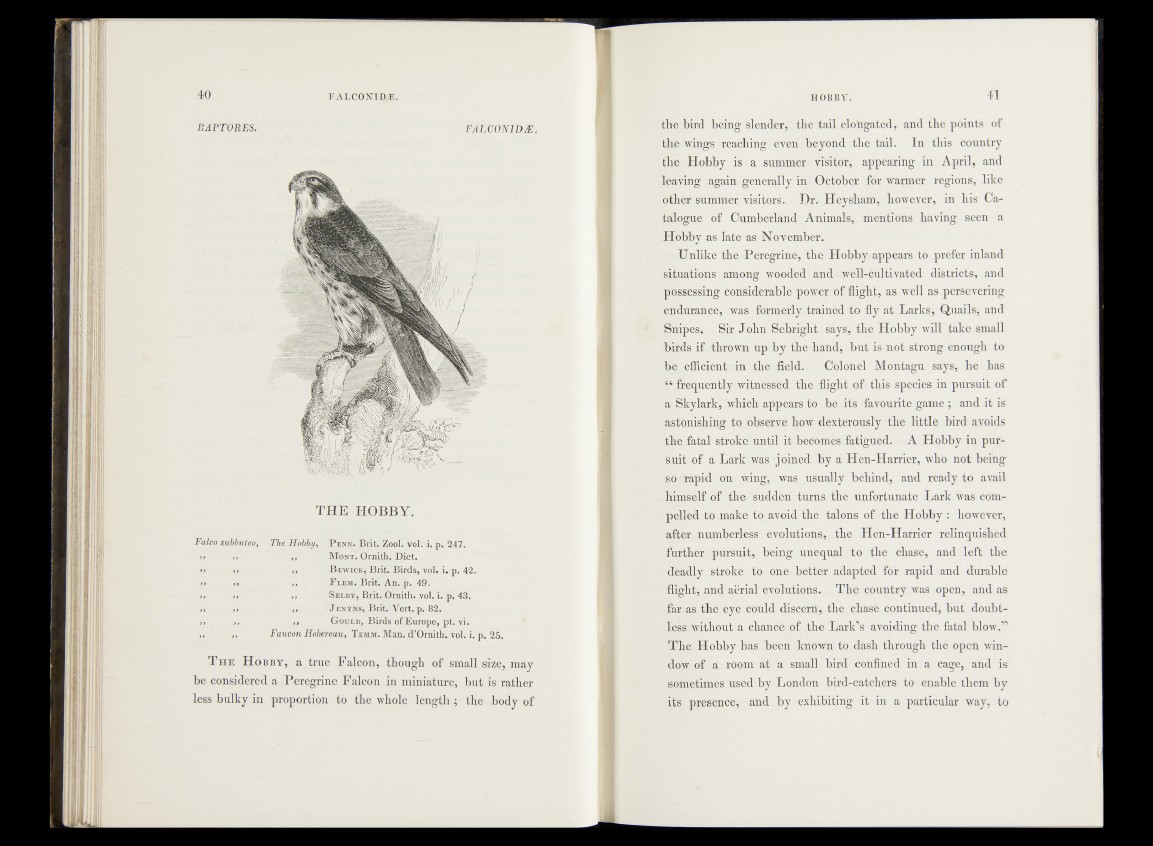
RAPTORES. FALCONIDÆ.
TH E HOBBY.
The Hobby, P enn. Brit. Zool. vol. i. p. 247.
,, Mont. Ornith. Diet.
,, B ewick, Brit. Birds, vol. i. p. 42.
,, F l em. Brit. An. p. 49.
,, Seeby, Brit.,, Ornith. vol. i. p. 43. ,, J enyns, Brit. Vert. p. 8 2 . Goued, Birds of Europe, pt. vi.
Faucon Hobereau, Temm. Man. d’Ornith. vol. i. p. 25.
T h e H o b b y , a true Falcon, though of small size, may
be considered a Peregrine Falcon in miniature, but is rather
less bulky in proportion to the whole length ; the body of
the bird being slender, the tail elongated, and the points of
the wings reaching even beyond the tail. In this country
the Hobby is a summer visitor, appearing in April, and
leaving again generally in October for warmer regions, like
other summer visitors. Dr. Heysham, however, in his Catalogue
of Cumberland Animals, mentions having seen a
Hobby as late as November.
Unlike the Peregrine, the Hobby appears to prefer inland
situations among wooded and well-cultivated districts, and
possessing considerable power of flight, as well as persevering
endurance, was formerly trained to fly at Larks, Quails, and
Snipes. Sir John Sebright says, the Hobby will take small
birds if thrown up by the hand, but is not strong enough to
be efficient in the field. Colonel Montagu says, he has
“ frequently witnessed the flight of this species in pursuit of
a Skylark, which appears to be its favourite game ; and it is
astonishing to observe how dexterously the little bird avoids
the fatal stroke until it becomes fatigued. A Hobby in pursuit
of a Lark was joined by a Hen-Harrier, who not being
so rapid on wing, was usually behind, and ready to avail
himself of the sudden turns the unfortunate Lark was compelled
to make to avoid the talons of the Hobby : however,
after numberless evolutions, the Hen-Harrier relinquished
further pursuit, being unequal to the chase, and left the
deadly stroke to one better adapted for rapid and durable
flight, and aerial evolutions. The country was open, and as
far as the eye could discern, the chase continued, but doubtless
without a chance of the Lark’s avoiding the fatal blow.”
The Hobby has been known to dash through the open window
of a room at a small bird confined in a cage, and is
sometimes used by London bird-catchers to enable them by
its presence, and by exhibiting it in a particular way, to